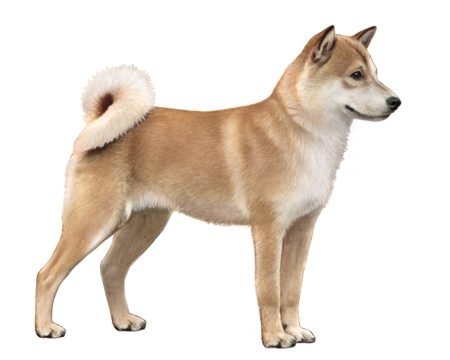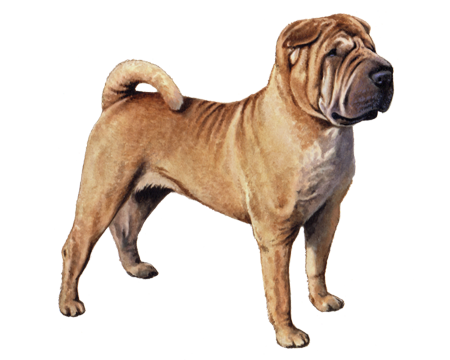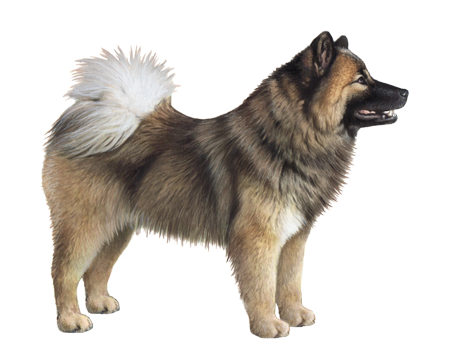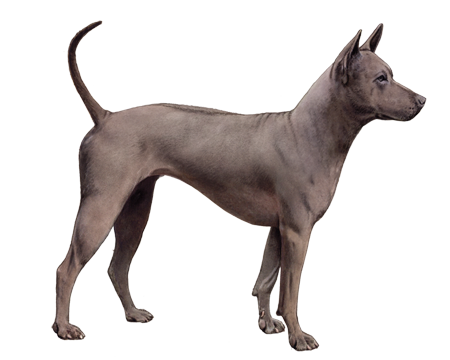
Hokkaido Inu
Descendants of hunting dogs, Hokkaido Inus make excellent watchdogs and companions. They're popular in Japan thanks to their adorable appearance and intelligent, protective nature. But the breed is rare elsewhere in the world.
Interested in discovering if your dog is a Hokkaido Inu?
Check out Wisdom Panel's DNA tests.

Hokkaido Inu Traits
General Appearance
The sturdy, medium-sized Hokkaido Inu is muscular and powerful. The breed has small, pricked ears, a dense coat, and a thick, curled tail.
Coat and Coloring
The Hokkaido Inu has a soft, dense undercoat and a coarse, straight outer coat—allowing it to withstand frigid temperatures. The hair on Hokkaido Inu's tail is longer than that of the body, and it stands straight out.
The breed standard allows for a range of colors. Sesame, brindle, red and black, black and tan, and white are all allowed.
Distinctive Physical Traits
Like many hunting breeds from Asia, Hokkaido Inus have high set tails with deep curves (like a sickle) and tips that can touch their hocks. Their small, triangular eyes turn up slightly at the outer edges.
Hokkaido Inu Temperament
As working dogs, Hokkaido Inus excel at completing tasks. They are active, agile dogs with stamina to spare. So, regular exercise and tall fences are essential.
Hokkaido Inus are also intelligent problem-solvers and faithful companions that develop strong bonds with their families. They prefer constant company over solitude and sometimes develop separation anxiety.
These dogs tend to be protective of family and nervous around strangers. And due to its hunting background, the Hokkaido Inu may chase or be aggressive toward other animals—including pets and wildlife. Though they sometimes tolerate small children (with supervision), Hokkaido Inus are best for homes with older children. When well-socialized, the Hokkaido Inu can make a great, docile family pet and protector.


Hokkaido Inu History
Hokkaido Inus are likely the oldest of the native Japanese spitz breeds—a group of six that includes the Akita, Kai Ken, and Shiba Inu. Experts believe the breed migrated with the Ainu people from Honshu to Hokkaido during the 1140s. There, the dogs (then known as Ainu Ken) adapted to the frigid temperatures and harsh landscapes while earning their keep as hunters.
Hokkaido Inus are known as "bear dogs," in part because they are fiercely brave. But as the need for bear-hunting dogs declined, the breed adapted to new roles as watchdogs and family companions.
The numbers of Hokkaido Inus remain small. And just two clubs in Japan—Hokkaido Ken Hozonkai (Hokkaido Dog Preservation Society) and Hokkaido Ken Kyokai (Hokkaido Dog Association)—have registered the breed. But the rarity of the ancient breed led Japan to declare Hokkaido Inus Living Natural Monuments, a protected species, in 1937.
Hokkaido Inu Care
Nutrition
Hokkaido Inus require a high-quality dog food that is age-appropriate—whether it's commercially manufactured or homemade (with a veterinarian's supervision and approval). This on-the-go breed may require extra calories to compensate for its active lifestyle.
That said, it's important to monitor the amount of food you give your Hokkaido Inu and reduce the portions or restrict calories if your pup gains excess weight. Also, remember that giving too many treats can contribute to obesity.
Grooming
Aside from regular brushing and a little extra grooming during the biannual shedding of their dense undercoats, Hokkaido Inus require minimal grooming. But be prepared to deal with a lot of dog hair—this is a heavy shedding breed.
The Hokkaido Inu has natural oils in its skin that promote a clean, thick, and shiny coat. Though this is a double-coated breed that prefers cold weather, seasonal shaving or trimming isn't required or recommended.
Hokkaido Inus also need frequent nail trims, ear cleanings, and routine dental care.
Exercise
The Hokkaido Inu does best in an active home. It will eagerly tag along with owners who go hiking, jogging, biking, or camping. And the breed excels at fast-paced endurance activities—such as dock diving, lure coursing, agility, flyball, rally, and weight pulling. Hokkaido Inus are excellent swimmers, as well.
The thick-coated Hokkaido Inu is most comfortable in colder temperatures. So, during warmer months, look for indoor activities to test their speed and stamina. Without adequate exercise, these intelligent, eager-to-please dogs can become bored, anxious, and destructive.
Hokkaido Inus are agile and can clear a short fence without much effort. The breed is also known for its strength. So, use a fitted harness and strong leash for regular walks. And avoid letting the Hokkaido Inu run off-leash in areas without secure fencing. Their hunting instincts may take over and lead them to run off.
Training
Hokkaido Inus are free-spirited and independent, which can make them difficult for inexperienced dog owners to train. Focus on consistent, rewards-based training that includes treats, toys, and praise to help your dog learn basic commands and become a well-mannered companion.
As an intelligent dog, your Hokkaido Inu may get bored with routine training. So, be sure to switch things up with new games and emphasize fast-paced activities that provide both physical and mental stimulation.
Finally, help your Hokkaido Inu overcome its uncertainty around strangers by starting socialization training in puppyhood.
Breed Group
Asian and Oceanian
The Asian and Oceanian group is comprised of breeds whose origins lie in Asia, which have spread as far as Australia, the islands of the Pacific, and the Arctic. This group is possibly the most ancient of all breed groups and were bred for a variety of purposes, including guarding, hunting, and as draft dogs.
Resources
https://www.akc.org/dog-breeds/hokkaido/
http://www.fci.be/Nomenclature/Standards/261g05-en.pdf
https://www.hokkaidoken.org/about-hokkaido.html
Reviewed July 26, 2020 by Cindy Elston, DVM, MPH












































